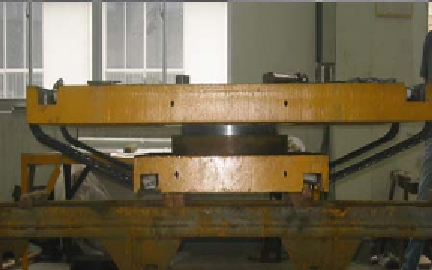Geology Reference
In-Depth Information
Figure 16. Prototype bearing
the fixed pier is PS1. For the new cable sliding
friction aseismic bearing used only on the fixed
pier PS1 in the bridge, the vertical load bearing
capacity is 35000 kN, the friction coefficient is
0.02 and the shear strength of the shear bolt is 3500
kN. The seismic responses are evaluated by using
an artificial synthetic ground motion (Figure 19),
whose excess probability is 3% in 100 years (Cao,
2009). The artificial synthetic ground motion is
applied in the longitudinal direction at the base of
the piles and abutments, while the vertical ground
motion is two thirds of it.
Since the stiffness of the cables is very impor-
tant for the new bearing, it is necessary to analyze
the seismic demand variations of the bridge along
with the stiffness of the cables. Parametric analy-
ses are conducted and the results are shown in
Figure 20, in which the left vertical coordinate
indicates the seismic shear force at the bottom of
pier PS1 and the right one indicates the maximum
longitudinal seismic displacement of the deck
end. It can be seen that the seismic displacements
of the deck end decrease rapidly, while the seismic
shear forces at the bottom of pier PS1 do not in-
crease too much, as the cable stiffness increases.
Yet the shear forces increases a little and the deck
displacement changes slightly when the cable
stiffness gradually increases from 1×10
5
to 3×10
5
kN/m.
bearing. The results also show that the experi-
mental hysteretic curves agree with the numerical
ones well and the displacement restraining capac-
ity of the cables is significant.
Application Study
From the above theoretical assumptions and
analyses, the new cable sliding friction aseismic
bearing seems sound and acceptable. After some
conformation improvements in order to be fit for
the requirements and convenience of manufac-
tures, the modified shop-manufactured bearing
shown in Figure 17 is applied in a girder-arch
composite bridge with spans of three 210 m, whose
finite element model is shown in Figure 18 and
Figure 17. Modified shop-manufactured bearing


Search WWH ::

Custom Search